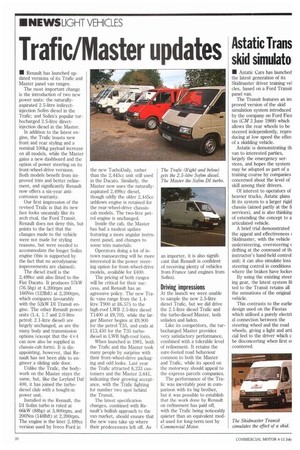Trafic/Master updates
Page 22

If you've noticed an error in this article please click here to report it so we can fix it.
• Renault has launched updated versions of its Trafic and Master panel van ranges.
The most important change is the introduction of two new power units: the naturallyaspirated 2.5-litre indirectinjection Sofmi diesel in the Trafic; and Sofinfs popular turbocharged 2.5-litre directinjection diesel in the Master.
In addition to the latest engine, the Trafic boasts new front and rear styling and a nominal 100kg payload increase on all models, while the Master gains a new dashboard and the option of power steering on its front-wheel-drive versions. Both models benefit from improved trim and better refinement, and significantly Renault now offers a six-year anticorrosion warranty.
Our first impression of the revised Trafic is that its new face looks uncannily like its arch rival, the Ford Transit_ Renault does not deny this, but points to the fact that the changes made to the vehicle were not made for styling reasons, but were needed to accommodate the longer Sofim engine (this is supported by the fact that no aerodynamic improvements are claimed).
The diesel itself is the 2,499cc unit also fitted to the Fiat Ducato. It produces 57kW (76.5hp) at 4,200rpm and 166Nrn (122lbft) at 2,200rpm, which compares favourably with the 52kW DI Transit engine. The other Renault power units (1.4, 1.7 and 2.0-litre petrol; 2.1-litre diesel) are largely unchanged, as are the many body and transmission options (except that the 4x4 can now also be supplied in chassis-cab form). It is disappointing, however, that Renault has not been able to engineer a sliding side door_ Unlike the Trafic, the bodywork on the Master stays the same, but, like the Leyland Daf 400, it has joined the turbodiesel dub with a bought-in power unit.
Installed in the Renault, the DI Sofim turbo is rated at 66kW (88hp) at 3,800rpm, and 200Nm (1481Lift) at 2,200rpm. The engine is the later 2,499cc version used by Iveco Ford in the new TurboDaily, rather than the 2,445cc unit still used in the Ducat°. Similarly, the Master now uses the naturallyaspirated 2,499cc diesel, though oddly the older 2,445cc unblown engine is retained for the rear-wheel-drive chassiscab models. The two-litre petrol engine is unchanged.
Inside the cab, the Master has had a modest update featuring a more angular instrument panel, and changes to some trim materials.
Operators doing a lot of intown manoeuvring will be more interested in the power steering option for front-wheel-drive models, available for E400.
The pricing of both ranges will be critical for their success, and Renault has an agressive policy. The new Trafic vans range from the 1.4litre T900 at £6,575 to the high-roof LWB 2.5-litre diesel T1400 at E9,705, while the larger Master begins at E9,900 for the petrol T35, and ends at £13,450 for the T35 turbodiesel in LWB high-roof form.
When launched in 1981, both the Trafic and the Master took many people by surprise with their front-wheel-drive packaging and odd looks. Last year the Trafic attracted 8,233 customers and the Master 3,641, indicating their growing acceptance, with the Trafic fighting for number two spot behind the Transit.
The latest specification changes, combined with Renault's bullish approach to the van market, should ensure that the new vans take up where their predecessors left off. As an importer, it is also significant that Renault is confident of receiving plenty of vehicles from France (and engines from Sofim).
Driving impressions
At the launch we were unable to sample the new 2.5-litre diesel Trafic, but we did drive the 2.1-litre diesel Trafic and the turbo-diesel Master, both unladen and laden.
Like its competitors, the turbocharged Master provides very satisfactory performance, combined with a tolerable level of refinement. It retains the sure-footed road behaviour common to both the Master and Trafic, while its speed on the motorway should appeal to the express parcels companies.
The performance of the Trafic was inevitably poor in comparison with its big brother, but it was possible to establish that the work done by Renault on refinement has paid off, with the Trafic being noticeably quieter than an equivalent model used for long-term test by Commercial Motor.




















































































































